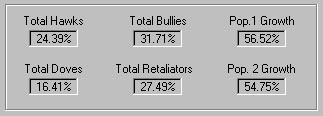
I have created a hawk-dove game simulation that uses a
specific population of hawks and doves and plays the game multiple times,
keeping track of births and deaths. It is useful for seeing how an
unbalanced population in the long run change its population dynamics to fit
equilibrium. The simulation can also model the strategies of bully and
retaliator. In the following, I will explain the different functions of
the simulator, the limitations, and what it can and cannot model. The
simulator looks as follows:

The simulation can accommodate for a various number of factors. It can simulate either one population competing for a resource within itself, or two separate populations competing for a resource. The one population model is used the most and fits most of the equilibrium situations previously described while the two population model does not necessarily follow these equilibrium. Thus, I would recommend keeping the simulator on the one population setting:
![]()
Death and reproduction thresholds can also be set in this simulation. Usually, each individual hawk and dove would have a certain number of points associated with it to indicate its fitness and when it will reproduce or die. However, because it would be difficult to monitor each member of the population, points are assigned to the hawk population as a whole, and the dove population as a whole. When the population's points reaches the reproduction threshold, an additional member of that strategy will come into existence and the score reset to zero. When the fitness points dip below the death threshold, a member of the population will be removed from the game and the score reset to zero. These thresholds can be adjusted here:


The bully and retaliator strategies can also be included here:
![]()
The matrix of payoff is shown in the upper left corner. The first number in each ordered pair is the payoff to the row player, and the second number is the payoff to the column player:

An added feature in this simulation is the number of turns to play the game. The longer the game is played, the more we can see the long term effects and the equilibrium distribution:

Mutations can also be added to the population by setting the mutations to a number higher than zero. It must be remembered that the number is a percentage, and if it is set to 0.1, then about 1 out of every 1000 births will result in a mutation of strategies. The mutations are limited to the 4 strategies hawk, dove, bully, and retaliator. This can be used to see the effects of introducing only a couple players with a new strategy into a population and watching the equilibrium shift:

Statistics about the total changes in the populations and final distributions are shown in the box on the middle left of the program. These results can be compared to the initial settings to find changes in population dynamics:

Results can be seen in the grid at the bottom of the program. Percentages of each strategy are shown for every turn and population number are also shown. This can be used to find rates of change, mutations and introductions, and other fluctuations that can't be seen in only the final results:

To run the simulation, set up all desired settings and click the "Start Simulation" button. Results will begin to appear, and the simulation will be done when the column titles in the grid reappear. The following are screenshots of the different situations expressed in previous sections of this web page.
Hawk and Dove equilibrium point
Hawk, Dove, Bully, Retaliator equilibrium
Doves introduced to Retaliator population
Hawks introduced to Retaliator population
Bullies introduced to Retaliator population